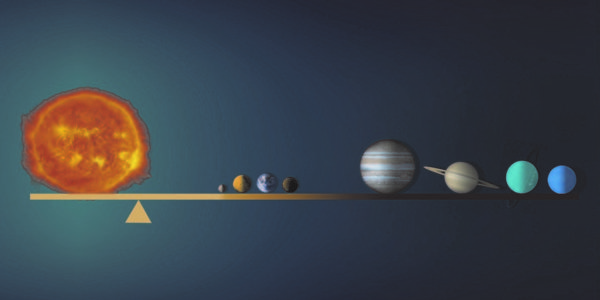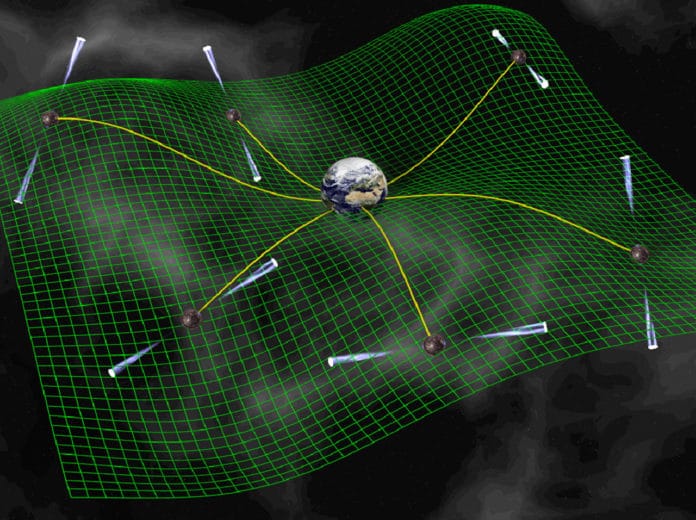A black hole is a region of spacetime where gravity is so strong that nothing—no particles or even electromagnetic radiation such as light—can escape from it. According to the theory of general relativity, a sufficiently compact mass can deform spacetime to form a black hole.
In the search for previously undetected black holes that are billions of times more massive than the Sun, scientists from Vanderbilt University with the North American Nanohertz Observatory for Gravitational Waves (NANOGrav) collaboration have moved the field of research forward by finding the precise location – the center of gravity of our solar system – with which to measure the gravitational waves that signal the existence of these black holes.
Scientists are figuring out the arrival rate of regular flashes of radio waves from pulsars. These pulsars are rapidly spinning neutron stars, some going as fast as a kitchen blender.
They additionally convey beams of radio waves, seeming like interstellar beacons when these beams sweep over Earth. More than 15 years of data have demonstrated that these pulsars are amazingly dependable in their pulse arrival rates, going about as remarkable galactic clocks. Any planning deviations that are corresponded across loads of these pulsars could signal the influence of gravitational waves warping our galaxy.
Stephen Taylor, assistant professor of physics and astronomy and former astronomer at NASA’s Jet Propulsion Laboratory (JPL), said, “Using the pulsars we observe across the Milky Way galaxy, we are trying to be like a spider sitting in stillness in the middle of her web. How well we understand the solar system barycenter is critical as we attempt to sense even the smallest tingle to the web. The solar system barycenter, its center of gravity, is the location where the masses of all planets, moons, and asteroids balance out.”
So, where is the center of the solar system?
It is not in the center of the Sun as many might assume, instead it is closer to the surface of the star. This is due to Jupiter‘s mass and our imperfect knowledge of its orbit.
Jupiter revolves or orbits around the Sun once every 12 Earth years. Just shy of the 15 years that NANOGrav has been collecting data. JPL’s Galileo probe (named for the famed scientist that used a telescope to observe the moons of Jupiter) studied Jupiter between 1995 and 2003 but experienced technical maladies that impacted the quality of the measurements taken during the mission.

Until now, scientists used data from Doppler tracking to identify the center of the solar system’s gravity. In this way, they estimated the location and trajectories of bodies orbiting the Sun.
JPL astronomer and co-author Joe Simon said, “The catch is that errors in the masses and orbits will translate to pulsar-timing artifacts that may well look like gravitational waves.”
Scientists were finding that working with existing solar system models to analyze NANOGrav data gave inconsistent results.
JPL astronomer and the paper’s lead author Michele Vallisneri said, “We weren’t detecting anything significant in our gravitational-wave searches between solar system models, but we were getting large systematic differences in our calculations. Typically, more data delivers a more precise result, but there was always an offset in our calculations.”
Scientists decided to search for the center of gravity of the solar system at the same time as sleuthing for gravitational waves. The scientists got more robust answers to finding gravitational waves and were able to more accurately localize the center of the solar system’s gravity to within 100 meters. To understand that scale, if the Sun were the size of a football field, 100 meters would be the diameter of a strand of hair.
Taylor said, “Our precise observation of pulsars scattered across the galaxy has localized ourselves in the cosmos better than we ever could before. By finding gravitational waves this way, in addition to other experiments, we gain a more holistic overview of all different kinds of black holes in the Universe.”
As NANOGrav continues to collect ever more abundant and precise pulsar timing data, astronomers are confident that massive black holes will show up soon and unequivocally in the data.
